The Kabardino-Balkar Autonomous Soviet Socialist Republic was established in 1922. In 1992, it became the Republic Kabardino-Balkariia, within the Russian Federation. Its capital is Nal’chik. The major languages of Kabardino-Balkariia are Kabardian, Balkar, and Russian.
This is a beginning guide to bibliographic tools for researchers of Kabardino-Balkariia. Though not a comprehensive overview, this guide outlines three primary ways researchers can access bibliographic information about Kabardino-Balkarian publications:
(1) Through the National Library of the Republic of Kabardino-Balkariia’s online library catalog
(2) Through the Russian National Library’s Department of Literature in National Languages imprint catalog
(3) Through the letopis’ pechati or print chronicles for Kabardino-Balkariia.
Additionally, this guide highlights other resources related to Kabardino-Balkariia’s history, culture, language, and national bibliography. Researchers may also want to consult the following online database for additional coverage: Elektronnyi katalog knig na iazykakh narodov RF i stran SNG on the homepage of the the Russian National Library. Lastly, this guide highlights the electronic library of the Republic of Kabardino-Balkariia.
Sources: The Great Soviet Encyclopedia (Volume 11, page 323); Ethnologue.
LIBRARY CATALOGS
Gosudarstvennaia natsional’naia biblioteka KBR im. T.K. Mal’bakhova
http://xn--90aae3anv.xn--p1ai/
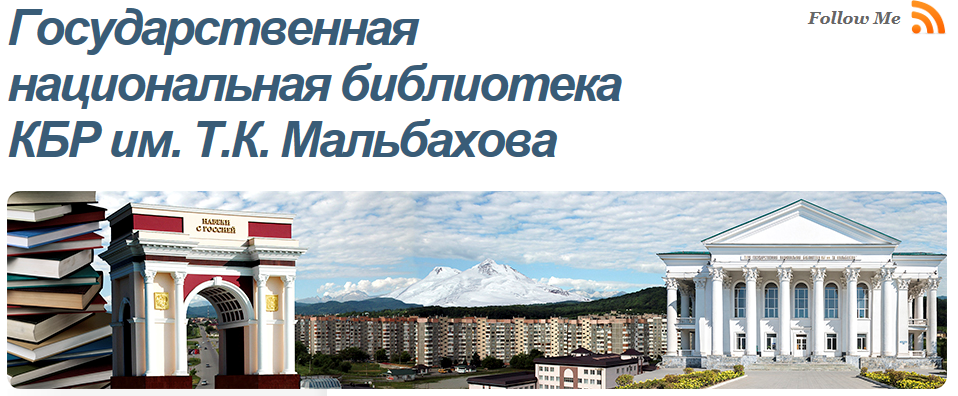
The T.K. Mal’bakhov National State Library was founded in 1923, and is the main library of Kabardino-Balkariia. The electronic catalog of the National Library of Kabardino-Balkariia (elektronnyi katalog GNB KBR im. T.K. Mal’bakhova) gives very basic bibliographic information for its holdings. Users can only search by keyword using a basic search query. The results are shown in a chart format which includes information about the title, place of publication, publisher, subject theme, and location. The image below shows sample results.
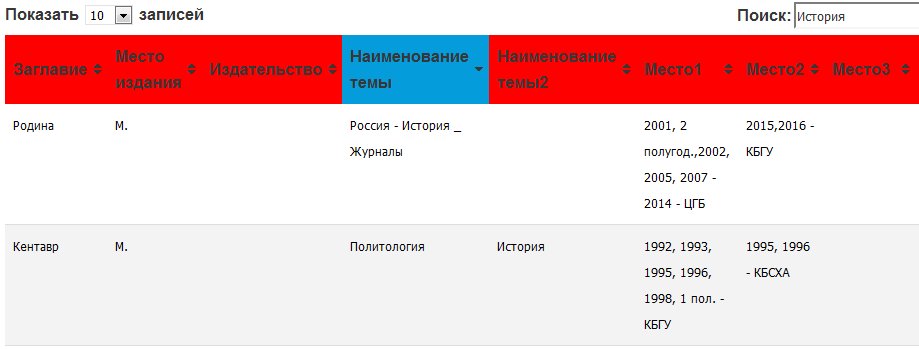
The database reflects the holdings of the following libraries:
- Gosudarstvennaia natsional’naia biblioteka (GKUK GNB)
- Kabardino-Balkarskii gosudarstvennyi universitet (KBU)
- Vsesoiuznyi geofizicheskii institut (FGBU BGI)
- Kabardino-Balkarskaia sel’skokhoziaistvennaia akademiia (KBAU)
- Pedagogicheskii kolledzh pri institute KBU
- Kolledzh dizaina pri institute KBU
- Institut povysheniia kvalifikatsii i podgotovki rukovoditelei organizatsii
- Tsentral’naia gorodskaia biblioteka periodiki
- Institut ekologii gornykh territorii
- Kabardino-Balkarskii institut biznesa
- KBIGI pravitel’stva KBR i KB nauchnogo tsentra RAN
- Nauchno-issledovatel’skii institut prikladnoi matematiki KB nauchnogo tsentra RAN
- Kabardino-Balkarskii institut gumanitarnykh issledovanii
- Tsentralizovannaia bibliotechnaia sistema. Gorodskoi filial No 10, Biblioteka periodiki
Please note that due to maintenance issues, this website may time out. This can be corrected by refreshing the page.
Katalog literatury na kabardinskom yazyke [microform] Rossiĭskai︠a︡ nat︠s︡ionalʹnai︠a︡ biblioteka. Otdel literatury na nat︠s︡ionalʹnykh i︠a︡zykakh.
New York: N. Ross, 1997. U of I Library Call Number: MFICHE 016.94752 R736k2 International and Area Studies Library, Microfilm Room. OCLC Accession Number: 702570182.
The Russian National Library’s Department of Literature in National Languages [also known as the Department of National Literatures] of the Russian Federation, Commonwealth of Independent States, and the Baltic countries has reproduced holdings catalogs in microfiche format. The national languages imprints catalogs in microfiche format diffuse most of the difficulties associated with transliteration in the vernacular languages, spelling, forms of entry, and uncertainties with the entirety of the collection. Researchers can access the entire holdings for a specific language at the Russian National Library through the microfiche set; conveniently exporting selected titles via PDF scans. The following scans reflect some of the Kabardian-language holdings available in microfiche format.
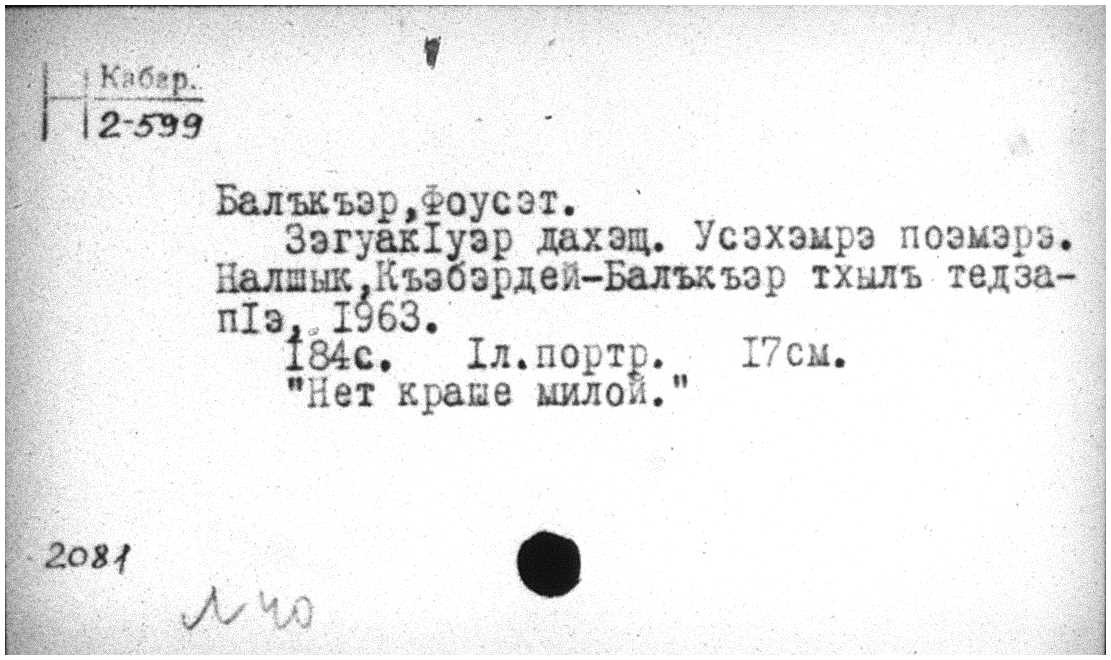
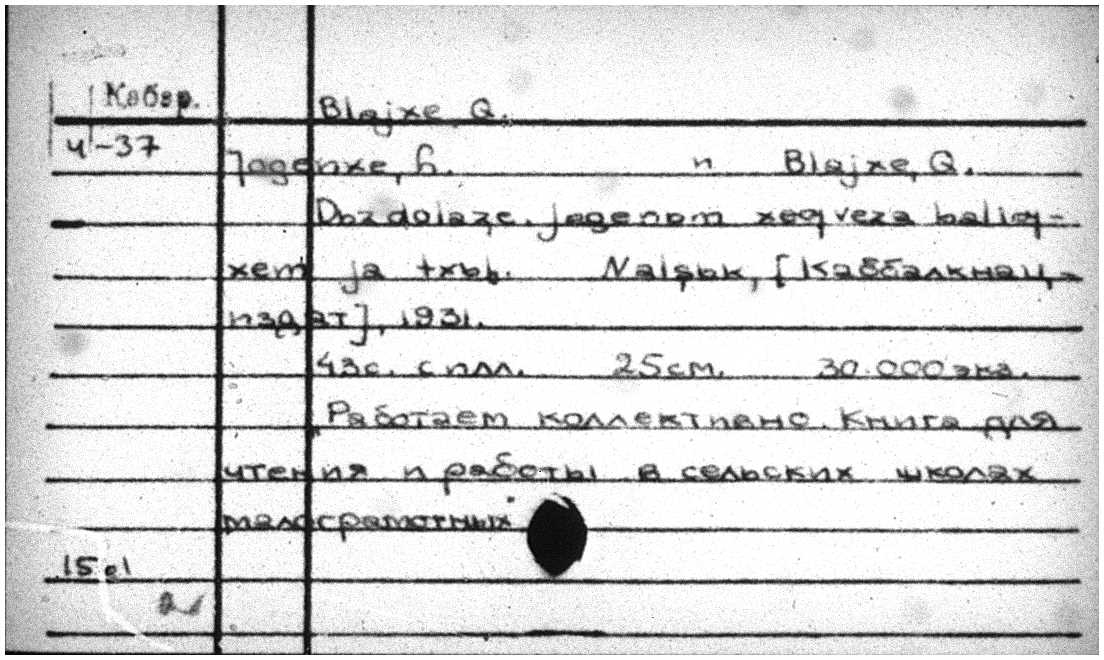
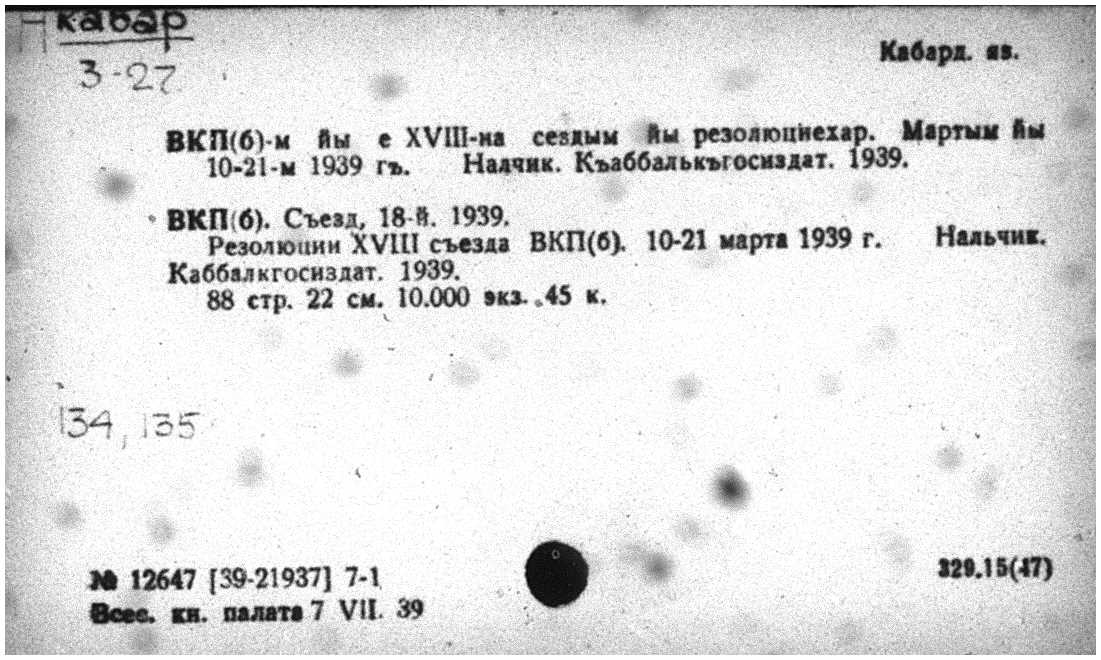
GENERAL RESOURCES
Publishing in Kabardino-Balkariia
In 1971, 123 books and pamphlets (625,000 copies), six periodicals (175,000 copies annually) and eleven newspapers (3.001 million copies annually) were published in Kabardino-Balkariia. The four republic newspapers and their first year of publication are the following: Lenin guegu (began in 1921) in Kabardian, Kommunizmge zhol (began in 1921) in Balkar, Kabardino-Balkarskaia pravda (began in 1921) in Russian, and Sovetskaia molodezh’ (began in 1939) in Russian. The following is a list of other periodicals published in Kabardino-Balkariia: Oshkhamakho (1958) in Kabardian; Shuiokhluk (1958) in Balkar; Bloknot agitatora (1951) in Russian, Kabardian, and Balkar; and Vachu enur (1961) in Kabardian. Users can consult Gazety SSSR 1917-1960: Bibliograficheskii spravochnik 5 for a list of newspapers published in the following languages of Kabardino-Balkariia between 1917 and 1960: Kabardian and Balkar.
Source: The Great Soviet Encyclopedia (Volume 11, page 323).
Letopisi pechati KBR
The Kabardino-Balkar Book Chamber, a department within the the T.K. Mal’bakho National Library began in 1958 with the creation of bibliographies of the publications in the republic, and the collection of physical copies of all these publications. One of the main responsibilities of the Book Chamber is the compilation and annual publication of the bibliographic guide letopis’ pechati KBP. The letopisi pechati are bibliographic records of all the books, dissertation abstracts, articles in journals and newspapers, and reviews published in the Republic of Kabardino-Balkariia during a given year. It covers many genres of published materials: scientific, official, educational, informational, literary, and other, including literature for children and youth. The descriptions of the titles are provided in the original languages and include a Russian translation. The collection of the national bibliography for the republic currently contains more than 21,500 items.
Through WorldCat, users can find issues of the letopis’ pechati for Kabardino-Balkariia in physical (OCLC accession number 145403349 or 34275819) and electronic form (OCLC accession number 610029549 or 747147714). However, on the website of the National Library of Kabardino-Balkariia, users can also download letopisi pechati from 1920-2016 as Word documents. The image below shows the organization of the letopis’ pechati.
Source: Gosudarstvennaia natsional’naia biblioteka KBP imeni T.K. Mal’bakhova, “Sektor gosudarstvennoi bibliografii“.
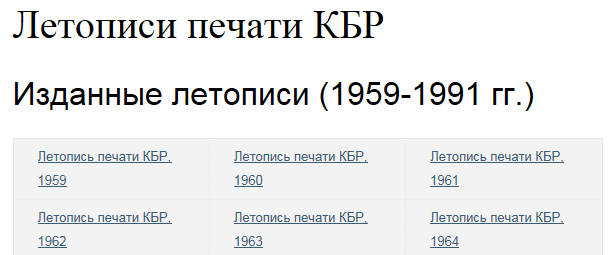
Note that the webpage is organized by the following subheadings:
- Published Letopisi pechati between 1959-1991
- Unpublished Letopisi pechati between 1992-2016
- Condensed bibliographic records (Pechat’ KBR) between 1921-1984
- Condensed bibliographic records (Pechat’ KBR) between 1982-2014
- Abstracts of dissertations between 1994-2013
Within each document, entry information for published materials includes: a general classification number given at the beginning of the section, a consecutive entry number, author, title, place of publication, publisher, date, pagination, illustrations, size, serial statement, ISBN or ISSN, number of copies printed, price, government registration number, e.g. [94-1546]; and other necessary bibliographic information for citations. An example of a letopis’ pechati entry is provided in the image below:
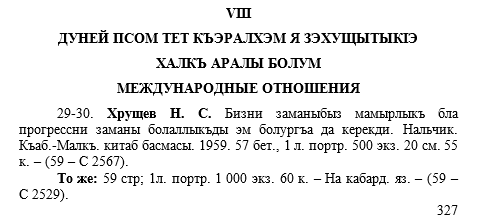
Language and keyboard
The major languages of Kabardino-Balkariia are Kabardian, Balkar, and Russian. Kabardian is a North Caucasian language and is also referred to as Beslenei, East Circassian, Kabard, Kabardino-Cherkes, Kabardo-Cherkess, Kabardo-Cherkessian, and Upper Circassian. Until 1924, the Kabardian written language used the Arabic and Cyrillic script. Between 1924, it used the Latin script, and since 1936, it has been based on the Cyrillic script. In addition to the characters of the Russian alphabet, it includes the letter Іi.
Balkar is a Turkic language and is also referred to as Balkarian, Balqar, Karacaylar, Karachai, Karachaitsy, Karachay, Karachayla, Malqartil, Qarachaytil, Taulu til, and Karachai-Balkar. The Balkar written language used the Arab script until the 1920s. Between 1924 and 1939 it used the Latin script, and since 1939, it has been based on the Cyrillic script. Its alphabet is the same as the Russian alphabet.
Users interested in working with vernacular languages in their research, can download a Cyrillic extended keyboard that can be used for Kabardian, Balkar, and many of the other national languages of the Russian Federation.
Sources: Ethnologue; Kabardino-cherkesskaia pis’mennost’; Karachaevo-balkarskaia pis’mennost’.
ONLINE RESOURCES
Elektronnaia biblioteka = Electronic library
The electronic library for the National Library of the Republic of Kabardino-Balkariia is not a database, but rather a list of categorized documents that can be downloaded as Word files or read online. Select works have been digitized and categorized under the following headings:
- Psychology
- Psychotherapy
- Computer graphics
- Psychology of sales and marketing
- Ethnography and history
- Biology
- History
- Physical culture